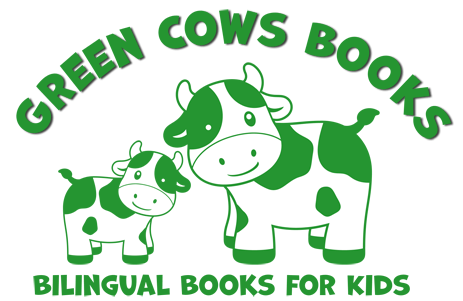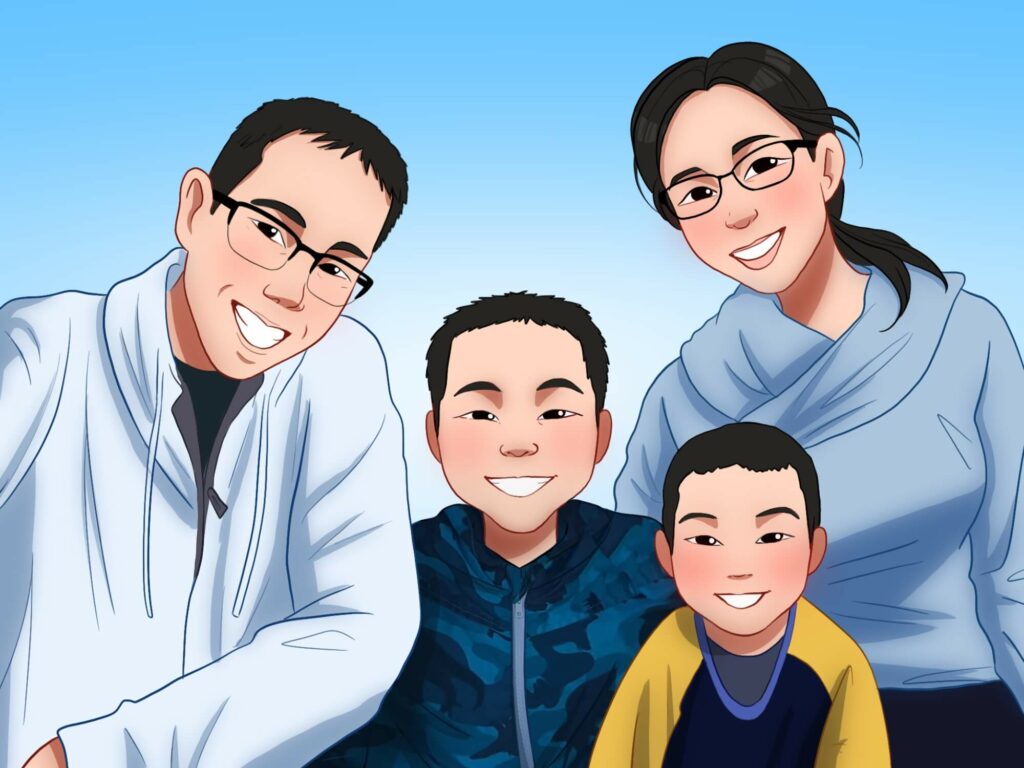“If flamingos turn pink when they eat so much shrimp, why don’t cows turn green when they eat so much grass?”
As parents, we’ve encountered a lot of thought-provoking – and often fun – questions. Some have been easier to answer than others. Some are asked by our kids, others are ones we’ve asked ourselves.
One question I wrestled with was: “Should we try to teach our kids Cantonese – and if so, how?” Trying to decide whether to teach our kids Cantonese was not easy. I spent hours researching, often searching online late at night, thinking through each of our language decisions and options. Then, after finally deciding to teach our kids Cantonese, I spent hours figuring out how to actually do that.

Amazingly, today, our entire household speaks Cantonese! Along the way, we created bilingual Cantonese picture books to support our own learning, which grew into our own indie publisher Green Cows Books, named for the fun questions that emerge out of bilingual learning – and out of parenting in general. Most importantly, we continue to have fun. I’m sharing our story, with all my doubts and second-guessing, in case it helps another parent.
How I got my entire family into speaking Cantonese
So…how did this turn into a family adventure? How did we go from one native (but limited) Cantonese speaker to the entire household speaking Cantonese? Why do I spend so much time making Cantonese-English picture books?
First, before my son was born, I made the reluctant – but relatively quick – decision that we were NOT going to teach him Cantonese. I was the only Cantonese speaker in our house, and even then, I had grown up in California and mainly learned “around the house” language. While I had attended weekend Chinese school, my reading and writing were limited. Simply put, I was intimidated. Other voices seemed to validate my fears: Parenting forums debated the wisdom of trying to teach kids multiple languages. Well-meaning relatives suggested Cantonese was a “dying language” and Mandarin might be more useful. And of course, there just weren’t Cantonese resources available. So we decided to focus our efforts on Mandarin, a language neither I nor my husband speak.
Then my son was born, and things changed. While my Cantonese was limited, speaking English to my own kid just didn’t feel like “home.” I decided that however basic my Cantonese was, I would try to pass it on. If I failed, nothing changed. But, if I succeeded, then my son would speak a “dying language” spoken by 74 million other people around the world.

So I began speaking Cantonese to our son – and this is where everything jumbles together time-wise. It was difficult at first – I felt awkward, and there were words I didn’t know (I had to learn them first!). We introduced Cantonese and Mandarin songs early on, but waited until our son turned 2.5 before introducing Cantonese cartoons (all on YouTube!). It was also tough for my husband for a while – once our son started speaking Cantonese, my husband could not understand what we were saying. But with a little one, we said the same phrases many times a day – “let’s go!”, “time to eat,” “drink your milk!”, etc. Somewhere along the way, my husband learned basic Cantonese.
Meanwhile, I searched non-stop for Cantonese books. I found a lot of books in Chinese and English; some books with Mandarin pinyin or zhuyin; and some books with Cantonese romanization. But I found nothing focused on spoken Cantonese.
So I began making my own Cantonese learning materials. I’d noticed that our board books had images of apples, ice cream and grapes – but nothing with Chinese food. So I printed out pictures of egg tarts, sesame balls, shrimp dumplings, almond tofu and tong yuen to learn alongside words like “apple” and “banana”. No disadvantage at the dim sum table for our son! I also included materials to support my husband – primarily key phrases such as “What do you want to eat?” and “I want to eat…” We’d quickly realized that just a few basic phrases go a long way towards communicating with toddlers!
Our materials worked amazingly well. When we finally took our 2-year-old to dim sum, he recognized a lot of the items. He even tried to order for himself: “daan taat!” (egg custard tart). (Though the waitresses paid very little attention to our toddler.) Eventually, I turned these materials into our first book, “My First Everyday Words in Cantonese & English.”

Today, our older one is trilingual. He learned Mandarin at daycare, Cantonese at home, and English. He was talking nonstop by 18 months. Our relatives generally also agree he has a better Cantonese accent than I do, even though he learned his Cantonese from me. I think he must have applied his Mandarin to Cantonese! His Mandarin is apparently excellent, and he was even chosen to represent his school at a reading contest.
Our 2-year-old is fluent for his age – he and his older brother speak Cantonese, but sometimes switch to Mandarin. While I’ve heard that learning multiple languages simultaneously can cause speech delays, neither of my kids experienced this. I think this might just be personality-driven! My husband now speaks Cantonese. And my mother-in-law also has picked up Cantonese. Being able to speak Cantonese (or even just understand the basics) has made for easier conversations with extended family.
So, where are we now in this learning adventure?
Our books are family activities. Topics are chosen by our kids, and each book is fully kid-approved. For example, every find-and-point-item – such as in Goh Goh and Dai Dai’s Big Day with Elephant – is thoroughly tested.
Our Mandarin translations are actually done by our older son. He’s been (informally) translating for us since he was able to talk, and translating books pushes him to stretch his Mandarin. He gets to choose kid-appropriate language – and his own pen name – to appear in the books. He’s also now started school – they teach English through what they call “Reader’s Workshop” and “Writer’s Workshop.” We now sometimes write together!
Honestly, I don’t have much of a roadmap. Some days, I can’t even think ahead to dinner and what we’re going to eat. I want us to continue creating books that are useful for parents and for kids, for everyday communication – but even if they’re meant to be educational, I want them to be fun and easy to read. As our kids have gotten older, we’ve also moved towards slightly more advanced story books. We’re also experimenting all the time. For example, we introduced a few other languages, including in Korean and German (our friends wanted to do their own translations!).
I hope that you will join us on our adventure!
I would love to hear from other parents who care about bilingual education. As a mom, I’d love to learn about what’s worked for you, and how you support your kids with their language learning. For those who are focused on Cantonese (or Mandarin), I’d love suggestions and feedback on future books. Please get in touch!
Originally featured by the Chinese Historical Society of America.

I agree!